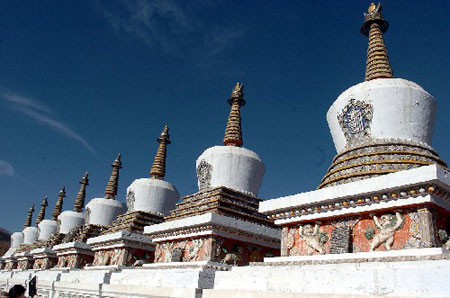
Photo shows symbolic architecture of eight towers on the square in front of the Ta'er Temple. (Xinhua Photo)
The Ta'er Temple is located at the southwest corner of Lusha'er Town in Niezhong County, Qinghai Province.
The Ta'er Temple is one of the six temples of the Gelug Sect of Tibetan Buddhism. The whole complex includes the Large Gold Tile Hall, the Small Gold Tile Hall, the Longevity Hall, the Large Classics Hall, the Manjusri Bodhisattva Hall, the Sakyamuni Hall, the Hall for Warrior Attendants of Buddha, the Amitabha Buddha Hall, the Time Wheel Tower, the large kitchen, the Eight Towers for Buddha, the Passage Gate Tower and other buildings, covering over 600 mu (40 hectares).
Inside the temple, there are four academies, namely the Xian (evident) Sect, the Mi (secret) Sect, the Astronomic Academy and the Medical Academy. The academies of the Xian and Mi were the places where the senior monks studied the Buddhist classics and doctrines, while the other two were the institutions of higher learning to foster excellent scientific and technical talents for the Tibetan and Mongolian nationalities. As a combination of the Tibetan and Han forms, the complex has a unique style. The layout is compactly organized and the towering buildings display great momentum with a resplendent and magnificent view.
The Ta'er Temple was the birthplace of Zongkaba, the founder of the Gelug Sect. In the 12thyear (1379) of the Hongwu reign in the Ming Dynasty (1368-1644), Zongkaba's mother built a pagoda at the birthplace of her son, and a tiled house to shelter it. This is the oldest religious building in the Ta'er Temple. In the 39thyear (1560) of the Jiajing reign in the Ming Dynasty, Monk Renqinzong Zhejianzan who was cultivating built a small Buddhist temple at the south foot of the Lotus Flower Mountain. In the 5thyear (1577) of the Wanli reign in the Ming Dynasty (1368-1644), a Buddhist monk built an Amitabha Buddha hall on the left side of the Daling Pagoda according to the order of the third Dalai Lama. After that, monks and disciples of all dynasties extended and refurbished the Ta'er Temple many times and made it more magnificent. It attracted tens of thousands of people in different nationalities such as the Tibetan, Han, Mongolian and so on to worship and became the center of Buddhist activities in the northwest. It enjoys fame far and wide and is the well-known Holy Land of Buddhism.
